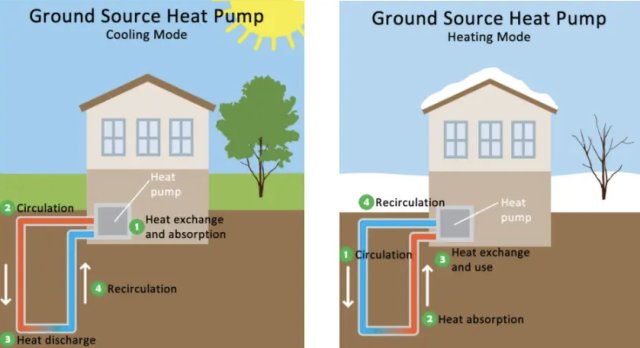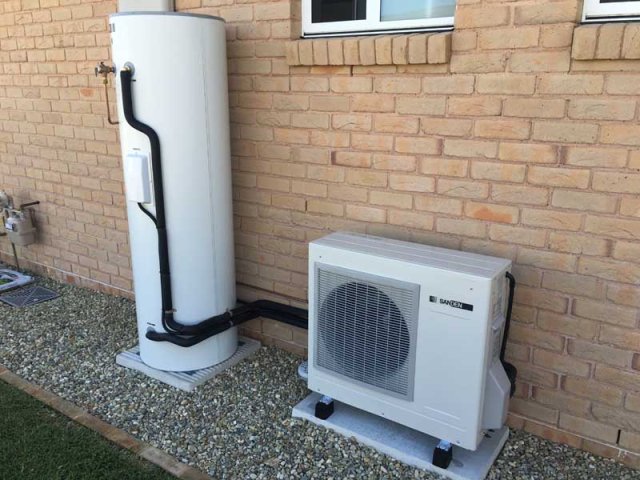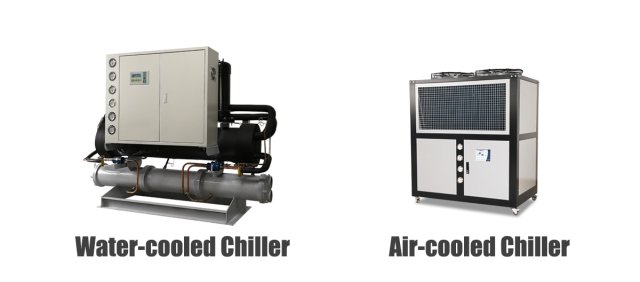Chillers and heat pumps share some familial resemblances as they both function based on the vapor compression or vapor-absorption refrigeration cycles. Yet, like any two individuals, they have their distinctive attributes, evident in their unique components and the mechanics of their operations.
- Chillers: Envision a chiller as a cooling specialist, single-minded in its mission. Its ensemble includes the compressor, condenser, expansion valve, and evaporator. The game begins with the compressor pressurizing the refrigerant. This high-pressure refrigerant then moves to the condenser, shedding heat and morphing into a semi-warm, high-pressure liquid. The refrigerant then swiftly expands at the expansion valve, resulting in a dip in both pressure and temperature. At the evaporator stage, the refrigerant siphons heat from the water needing cooling, transmuting back into a gas. This gas returns to the compressor, and the cycle recommenced.
- Heat Pumps: They boast the same key components – compressor, condenser, expansion device, and evaporator. But they have a twist in the plot: a reversing valve. This little gadget allows the heat pump to change the direction of the refrigerant flow, enabling it to heat or cool your space. In cooling mode, it mimics the chiller but switches to heating mode, and the narrative alters. The reversing valve swaps the roles of the condenser and evaporator: the evaporator absorbs heat from the outdoor air or ground (yes, even in frigid conditions, there’s heat energy lurking) and the condenser releases this heat indoors.
In essence, the major difference between them boils down to the heat pump’s reversing valve, which imparts dual functionalities: heating and cooling. Whereas chillers are cool – exclusively cool.
Heat Pump Classifications
There are several classifications of heat pump systems, namely Air Source Heat Pumps (ASHP), Ground Source Heat Pumps (GSHP), and Water Source Heat Pumps (WSHP). Each class operates on a different medium for its heat absorption and rejection process.
Air Source Heat Pump

An ASHP, as suggested by the name, draws or releases heat to the surrounding air. Whether heating or cooling, these systems take heat from the outdoor air and distribute it indoors, or perform the inverse operation. They present a less complex installation process, leading to a lower upfront investment. However, their performance efficiency can fluctuate, being highly susceptible to external weather conditions.
Ground Source Heat Pump

Contrastingly, GSHPs tap into the steady temperatures beneath the Earth’s surface for their heating or cooling needs. These systems necessitate an underground pipe network through which they extract or reject heat. This class of heat pumps calls for a substantial initial expenditure, such as drilling operations, but their consistent operational efficiency and reliability typically outweigh that of ASHPs due to the earth’s stable temperature.
Water Source Heat Pump

WSHPs, on the other hand, utilize a body of water — a lake, well, river, and so on — for heat extraction or expulsion. Suitable for regions with accessible subterranean water bodies, these systems make the most of the water’s high thermal conductivity, rendering them more efficient than ASHPs. However, they demand an adequate water source and careful consideration of potential impacts on the water source, including alterations to water temperature or ecological changes.
Chiller Classifications
Chillers, as essential components in HVAC systems and industrial cooling, mainly come in two types based on their cooling method: air-cooled chillers and water-cooled chillers.

Air-Cooled Chillers
Just like their name suggests, these units use air to remove the heat. As a simple, cost-effective solution, they are easy to install and don’t require access to a water source. Similar to air-source heat pumps, they draw on the ambient air for their cooling process. However, they can struggle in very hot climates due to the higher air temperature.
Water-Cooled Chillers
These units utilize water for cooling, which often makes them more efficient than their air-cooled counterparts. They, however, require a continuous water supply and additional equipment such as cooling towers and condenser water pumps. Just like water-source heat pumps, they leverage water’s thermal properties to exchange heat, providing superior performance in many situations.
Conclusion
Summing up, this article has opened the door to understanding chillers and heat pumps, unveiling their key similarities, differences, and application areas. From the balance between air-cooled and water-cooled chillers to the versatility of heat pumps, the right choice hinges on numerous factors—each situation has its unique solution.
At SCY Chillers, we’re committed to providing top-tier, efficient chilling solutions for all scenarios. Whether you need a compact air-cooled chiller for a small project or a heavy-duty water-cooled chiller for industrial needs, we’ve got you covered. With SCY Chillers, you’re not just buying a product; you’re investing in quality, reliable performance, and a cooler, more comfortable future.
FAQs
Q1: How are chillers and heat pumps different from each other?
A1: Heat pumps can do both – warm up and cool down a space because they’ve got a reversing valve that alters the flow of the refrigerant. Chillers, on the flip side, they just cool things down. Though they’ve got similar components, how these components are put together and how they interact varies because they’ve got different jobs to do.
Q2: Can I turn my chiller into a heat pump?
A2: Not really. The key difference between these two is the reversing valve that a heat pump has, which a chiller doesn’t. This valve is what allows a heat pump to switch the direction of the refrigerant and heat or cool a space.
Q3: What types of heat pumps are there?
A3: You’ve got three main types – Air Source Heat Pumps (ASHP), Ground Source Heat Pumps (GSHP), and Water Source Heat Pumps (WSHP). The big difference is what they use to extract and get rid of heat – it’s either air, ground, or water.
Q4: What are the main kinds of chillers?
A4: Chillers fall into two main categories based on how they cool down things: air-cooled chillers and water-cooled chillers. Like the name suggests, air-cooled chillers use air to take away the heat while water-cooled chillers use water.
Q5: How do the costs of chillers and heat pumps compare?
A5: Costs can vary a lot depending on the specific model, size, and the tech involved. Generally speaking, heat pumps have a lower upfront cost but higher operational costs, especially for heating. Chillers, especially the water-cooled types, often have higher upfront costs but lower operational costs because they’re more efficient.

تبريد المياه من35الي15درجة مئوية علامدار الساعة ماء جاري
مرحباً، ما هي السعة التي تحتاجها؟
Buenas, es posible contactar un chiller o una bomba de calor a un sistema hidroponico, a pesar de tener varios tanques para cada mesa o bancada,, se puede centralizar con un chiller?
te dejo mi whatsApp por las dudas +595 981 453 804